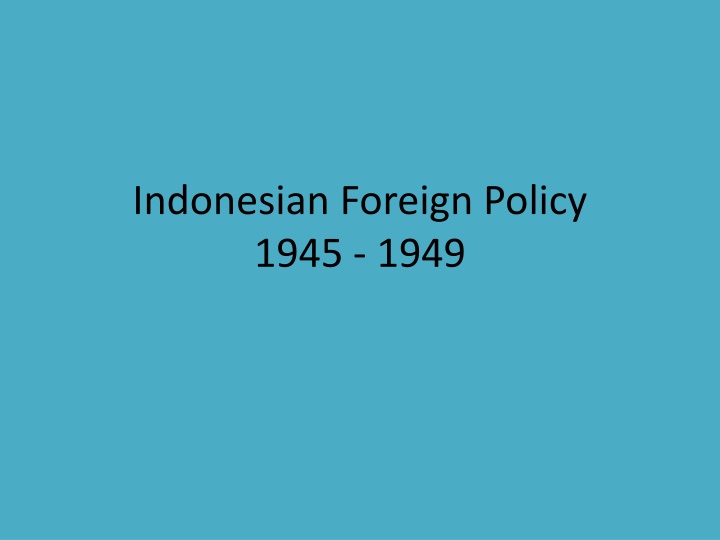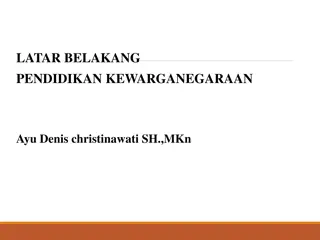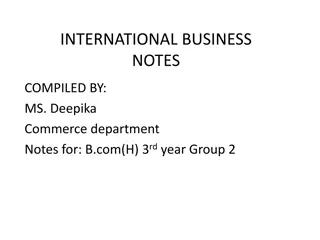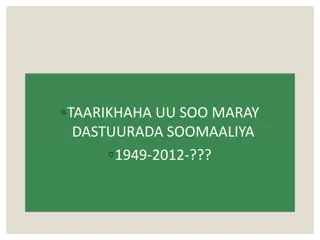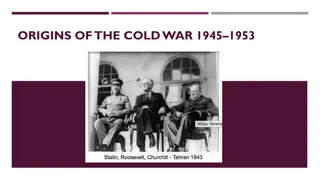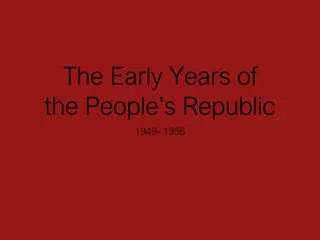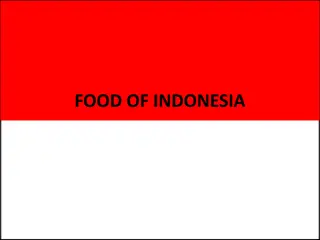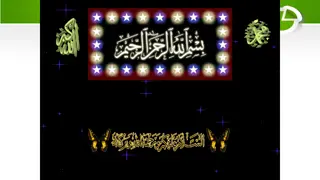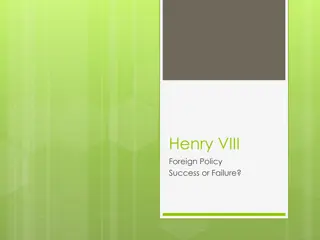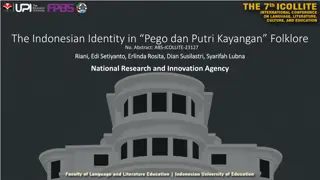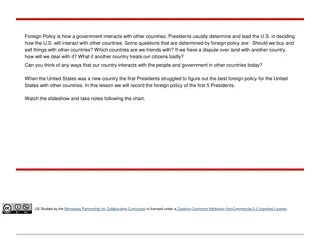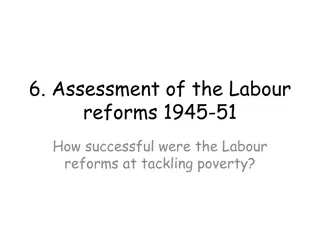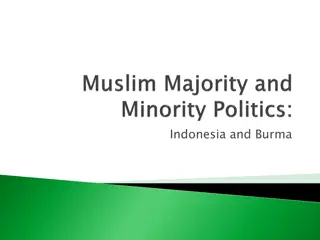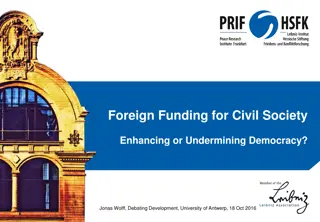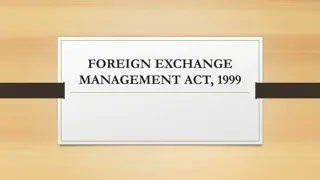Indonesian Foreign Policy Studies 1945-1949
This course focuses on analyzing Indonesian foreign policy from 1945 to 1949, exploring the historical, issue-based, regional, bilateral, and decision-making approaches. It delves into how Indonesia navigates international challenges to achieve its national objectives through various diplomatic strategies.
Download Presentation

Please find below an Image/Link to download the presentation.
The content on the website is provided AS IS for your information and personal use only. It may not be sold, licensed, or shared on other websites without obtaining consent from the author.If you encounter any issues during the download, it is possible that the publisher has removed the file from their server.
You are allowed to download the files provided on this website for personal or commercial use, subject to the condition that they are used lawfully. All files are the property of their respective owners.
The content on the website is provided AS IS for your information and personal use only. It may not be sold, licensed, or shared on other websites without obtaining consent from the author.
E N D
Presentation Transcript
Indonesian Foreign Policy 1945 - 1949
What do we study in this course? All actions and policies which are meant to respond to the constraints and opportunities in the external environment in order to attain national objectives. All efforts by the Indonesian government to affect the international environment so that the achievement of national objectives can be facilitated.
Different approaches in studying Indonesian foreign policy: Historical approach: To analyze change and continuity in the historical evolution of the Indonesian foreign policy since independence until today. To see how different regimes or governments respond to the international challenges in order to accomplish foreign policy objectives. To make an evaluation of the effectiveness of Indonesian diplomacy in time series studies.
Issue approach: To analyze how Indonesian foreign policy responds to a particular issue on the basis of our national interests. For instance: How the Indonesian government reacts to the issue of human rights, good governance, environment, foreign debt, human trafficking, cybercrime, money laundering, proliferation of nuclear weapons, the war on terrorism, etc.
Regional and Multilateral Approach To analyze Indonesia s role in various forms of regional cooperation like ASEAN, AFTA, ARF, APEC, etc and in multilateral diplomacy such as the United Nations and its affiliated organizations. To analyze how Indonesia can use these international institutions to achieve its foreign policy objectives.
Bilateral approach: To analyze Indonesia s relationship with another country: US, Australia, China, Japan, Singapore, Malaysia, etc.
Decision-making Approach: To analyze how the Indonesian foreign policy is made in order to understand foreign policy inputs, process, and outputs. To identify the actors and their interests and strategies in affecting foreign policy making in order to achieve their respective objectives. To analyze bureaucratic politics in foreign policy making: competition among govt. agencies in influencing foreign policy outputs.
State-centric approach: The study of foreign policy which focuses on the role of the government especially the executive power who claims to represent the state in the formulation as well as implementation of foreign policy. This approach is suitable for analyzing the foreign policy of authoritarian states where the role of the government is dominant. Example: Indonesian foreign policy under Soeharto.
Societal, pluralist, or democratic approach: To analyze how the process of democratization or political liberalization affects the making and implementation of foreign policy. To analyze how the political parties and different factions in the parliament compete to influence foreign policy making and implementation. To analyze how civil society groups try to affect foreign policy for certain issues. How the political leaders use or exploit foreign policy to mobilize political support among domestic political constituencies. The role of public diplomacy
Idiosyncratic approach: To analyze how the unique personal characteristics of national leaders affect the content and modalities of foreign policy. For instance: How Soekarno s personalities affected foreign policy during the period of Guided Democracy. How Soeharto s Javanese culture affected his foreign policy and diplomacy.
Intermestic approach: The study of foreign policy which takes into account the interlinkage and overlapping between international issues and domestic concerns. In this era of globalization almost all policy issues have their own global or international dimension. The role of the media is crucial in the internationalization of domestic issues and the internalization of global issues.
International Context or Environment The general situation of international relations which affected the conduct of Indonesia s foreign policy during this period.
The end of the Second World War II: the victory of the Allied Forces under the leadership of the US and the defeat of Japan. Leading to the liberation or freedom of Japan s colonies or occupied territories in Southeast Asia including Indonesia.
The competition and rivalry between the US (the West) and Soviet Union (the East) just began. Both of them were trying to expand their respective sphere of ideological and political influence the beginning of the Cold War.
It was also the era of decolonization many newly independent states emerged in Asia and Africa. Common experience and shared history of colonization led to the formation of solidarity Asia Africa Conference in 1955. They needed each other s help to increase bargaining position vis a vis the colonial state or the West
The Dutch colonial rule wanted to reestablish their control over Indonesia on the basis of an argument (misperception) that Indonesian independence was a political trick by Japan in order to create political difficulties for the allied forces.
The Supreme Commander of the Allied Forces, Netherlands East Indies, Lt. General Sir Philip Christison recognized the de facto authority of the government of RI.
The existence of the United Nations which was newly established for the preservation of international order and peace. The UN played an important role of the new nations as it provided an international arena for negotiations and dialog.
Domestic Situation and Conditions
The proclamation of Indonesian independence on 17 August 1945 by Soekarno and Hatta
The insistence of the Indonesian leaders and the people to maintain independence and resist the reestablishment of the Dutch colonial rule. The whole attention of the government of Indonesia was to concentrate on ending the Dutch colonial rule
Those who were accused of collaborating with the Japanese government like Soekarno and Ahmad Subardjo Those who rejected any collaboration with the Japanese government like Sutan Sjahrir cs. There was a change from presidential system to parliamentary system.
A division among Indonesian elite or leaders. President Soekarno and his foreign minister.
Indonesia was confronted with immense problems of nation-building and economic development as a basis for conducting effective foreign policy. There was the problem of what to do with the newly obtained independence.
The central government had a weak control over the regions facilitating the coming establishment of the United States of Indonesia (RIS) when the Dutch government tried to capitalize on its divide and rule policy.
How Did Indonesia maintain its independence?
Military Struggle: Indonesian armed forces had to face two military actions by the Dutch government in 1947 and 1948.
Diplomacy International Negotiations and Mobilization of international support especially in Asia and the United Nations. The UN stepped in after the Indonesian question was brought before it by India and Australia.
The struggle against the Dutch received only ambiguous support from the major powers, especially the United States which assisted the Dutch diplomatically and militarily until December 1948 The refusal of Western power to order the Dutch to withdraw from the territory they had occupied by force undermined the initial hope of Indonesian leaders that the West, and especially the US would favor national self- determination.
The struggle against the Dutch received only ambiguous support from the major powers, especially the United States which assisted the Dutch diplomatically and militarily until December 1948 The refusal of Western power to order the Dutch to withdraw from the territory they had occupied by force undermined the initial hope of Indonesian leaders that the West, and especially the US would favor national self-determination.
In foreign policy the rivalry within the leadership revolved around two significant questions: how to deal with the Dutch (diplomatic strategies) and the issue of defining Indonesia s international identity (foreign policy orientation).
In foreign policy the rivalry within the leadership revolved around two significant questions: how to deal with the Dutch (diplomatic strategies) and the issue of defining Indonesia s international identity (foreign policy orientation).
The Sjahrir cabinet, for example, was forced to resign in June 1947, charged with compromising Indonesia s initial position after the conclusion of the Linggajati Agreement. Sjahrir s successor, Amir Sjarifuddin, was also forced to resign in January 1948 due to his acceptance of the Renville Agreements.
Given the growing antagonism of between two opposing blocs, the various competing elites, who were divided along ideological and political lines, differed on the position Indonesia should take. Some Indonesian leaders insisted that Indonesia should support the Soviet Union Madiun Affair 1948.
Moh. Hatta, as prime minister, on September 2, 1948 before the Central Indonesian National Committee (KNIP) laid down the basic elements of Indonesia s foreign policy in his speech titled: Mendajung antara Dua Karang the birth of foreign policy bebas aktif.
First, the conduct of foreign policy should be based on an ideological foundation: Pancasila
Second, foreign policy should be aimed at safeguarding the national interests as defined in the Constitution.
Third, the pursuit of national interest would be best served through an independent policy. It is not one of neutrality as Indonesia will not just react to the belligerent states. The emphasis is on our independent judgment.
Fourth, Indonesias foreign policy should be conducted pragmatically, that is, it should be resolved in the light of its own interests and should be executed in consonance with the situations and facts it has to face .
Indonesian Principles of Foreign Policy: How they were invented
Anti colonialism Self-reliance Nationalism Independent and active foreign policy
Lessons we may learn from the conduct of RIs foreign policy during the period of 45 49:
A good and effective diplomacy is one with a clear purpose and strong intentionality.
Self-reliance and self-confidence can help the nation to accomplish its foreign policy goals. Conversely, too much dependence on the willingness of other nations to help can hinder the achievement of foreign policy goal.
Unity and solidarity among leaders is important for the effectiveness of foreign policy implementation.
The conduct of foreign policy and diplomacy should be based on a clear vision.
Solidarity among Asian countries played an important role in RI s foreign policy. A hybrid for Asia Africa Conference in 1955 and the Non-aligned Movement in early 1960s.
